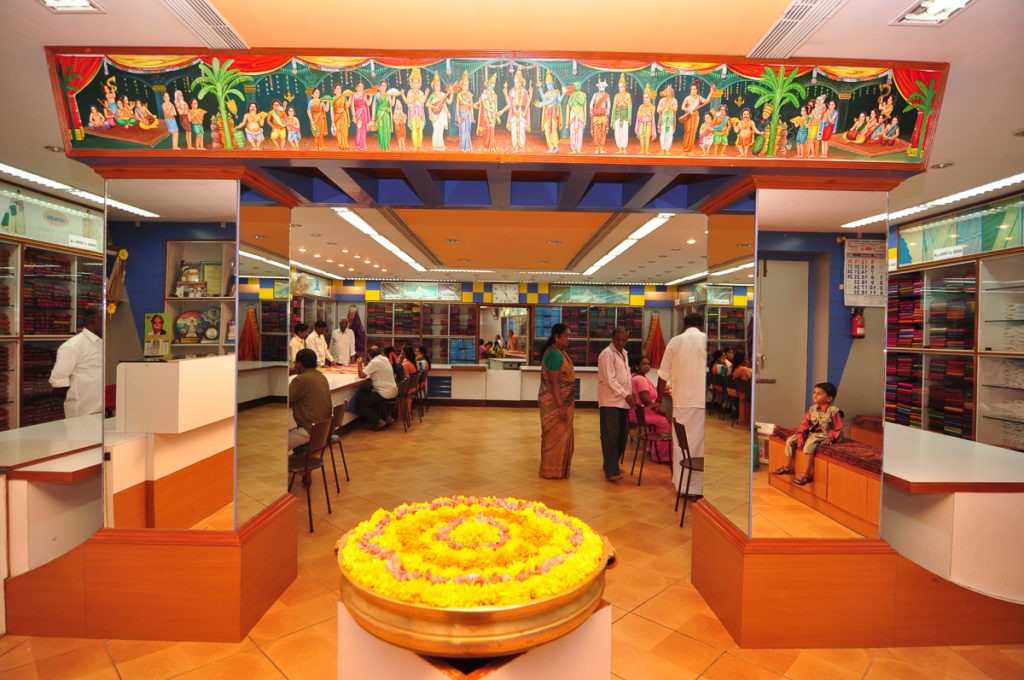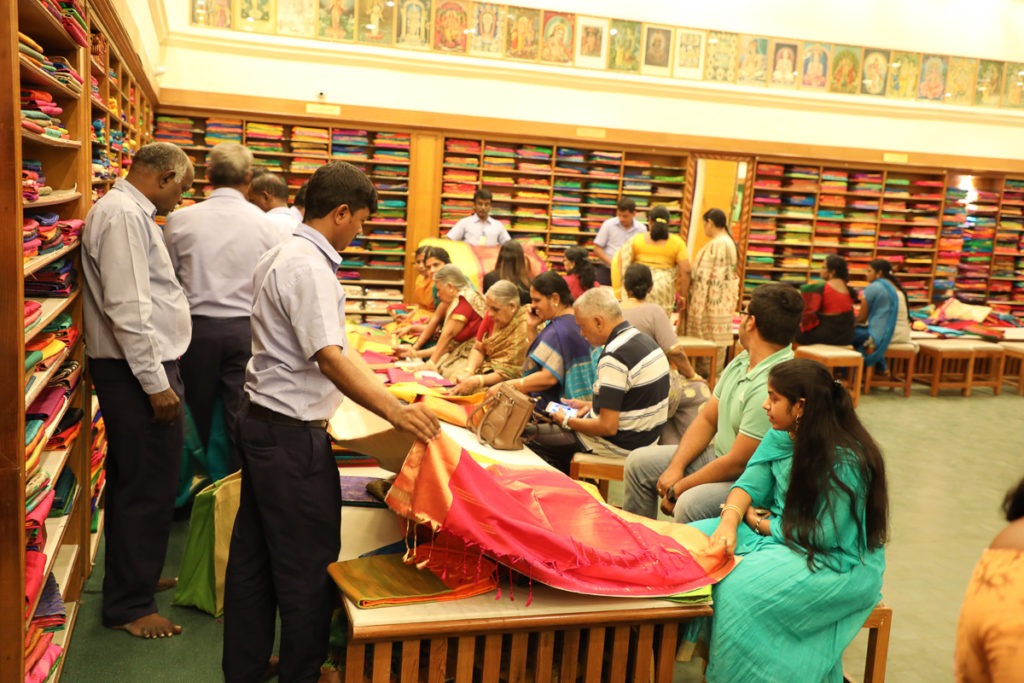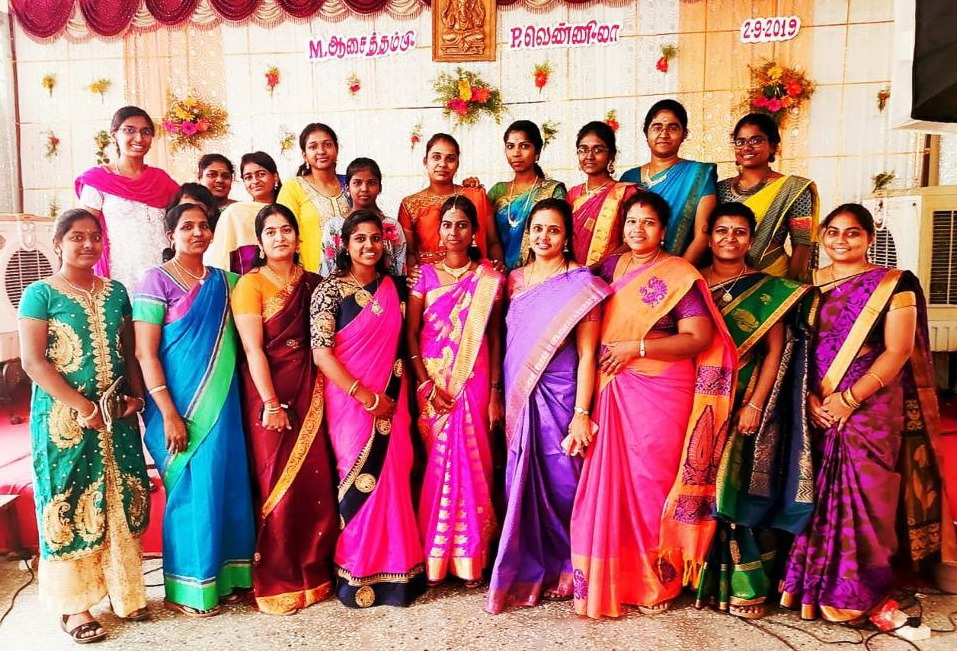Aarti Kawlra explains the painstaking efforts of the Telugu-speaking weaving caste, Padma Saliyars, to heighten auspiciousness in their wedding saris.
The Tamil term for auspiciousness is raasi. In its literal application, the word refers to a sign of the zodiac to denote an individual’s planetary constellation and is borrowed from Sanskrit to mean collection, disposition, harmony and luck. Its usage is based upon the assumption common to South Asian systems of healing and astrology that humans are in a dynamic relationship with the socio-cosmic environment in which they exist. Achieving an appropriate state of balance with the universe involves a continuous orientation and reorientation of the body in time and place. As time proceeds and as spatial directions change, humans also change their nature and condition as they are embedded in the very fact of continual change.
According to this schema, individuals, regardless of their caste status, are prone to both auspicious (nalla raasi) and inauspicious (ketta raasi) influences. For the Padma Saliyars, the intersection and conjunction of opposed elements and their transformations in the daily practice of work and life allude to the augmentation of auspiciousness as a desirable goal. Weavers are very particular about dates and time periods considered to be auspicious and meticulously consult the almanac often pasted or hung by the side of their loom before commencing the activity of weaving.
Work is the quest not only of material well-being, but also an accrual of “good” influences in daily life. Given life’s sorrows and joys, failures and fortunes, vices and virtues, auspicious procedures in weaving processes and in the exchange of the sari tend to keep the balance more towards the latter than the former states. Maintaining an optimal balance in the different levels the pragmatic and the moral-in daily life, it is believed, will tend to shift the elusive bargain between the auspicious and the inauspicious in one’s favour.
The relevance of this discourse in the realm of the practical activity of weaving for the Padma Saliyars is apparent in their pursuit of auspiciousness through an adherence to ethical prescriptions in the weaving and exchange of silk saris. The korvai sari is woven as a garment unit through the conjunction of opposed elements along three design parameters-colour and texture and ornamentation. The korvai technique of using extra shuttles for border weaving highlights the design of the sari as a draped garment by differentiating its three parts-border, body and pallav or end-piece, from each other and uniting them as an individual sari and separating it from other saris in the same warp. The value of these saris pertains not only to the price of gold and silver admixture used in it, but also to its non-monetary worth or raasi embodied in the way it is woven and sold or purchased.
Nalli Kuppuswami uses the language of metaphor to describe the protective (mitigating inauspiciousness) quality of the border-body-end-piece design format of the korvai sari to draw out its inalienable value beyond price for his customers. He shares his ideas in a semi-autobiographical ethical treatise titled Work is Worship (1983) written both in Tamil and English and distributed free of charge for patrons and members of his community: “As the two banks of a river act as a check on the flood waters and prevent them from entering the village and causing damage and also help to canalize them to avoid wastage, the borders in a silk sari act as its fort to protect and preserve its beauty and color.” For him, the purity of gold employed is surpassed only by the ceremonial grandeur of its distinctive placement in the sari: “Like the tilak (or vermillion mark of Hindus) adorning the forehead, zari adorns the silk sari.” These descriptions of the design of the silk korvai sari exceed the aesthetic or functional and are explicit in their allusion to the wider context of use in augmenting auspiciousness for its wearer.
Silk and gold saris are principal objects of gift exchange at life-affirming ceremonies such as weddings, births, collective rituals and festivals in temples in Tamil Nadu. The wearing of and giving/receiving of silk cloths at auspicious occasions as well as offering them to deities in temples is ritually prescribed among many groups in south India. The sari of a married woman must be bordered, whereas that of a widow’s is always plain and undifferentiated without any borders. It is this visual differentiation in sari design that marks a woman as a sumangali, literally woman with mangalami or “auspiciousness” in south India and points to her ability to attract benevolent and life-affirming forces. A wedding sari is distinguished by its colours arakku (vermillion red) and manjal (turmeric yellow), which are already part of a married woman’s toilet. The vermillion red of the pottu worn on the forehead and the yellow of the turmeric used on the face and body are considered to enhance the propitiousness of a married woman. Writing about the colour combinations of the Kanchipuram sari favoured by the traditional elite in Madras, Prema Srinivasan notes that “women favored the auspicious pitaambaram reds and yellows, either as separate colors, or in the same weave (i.e. in the same sari], or by marrying yellow and red warp/weft threads.” Widowhood is marked by the divestiture of all these elements that augment auspiciousness in the daily life of a married woman.
In Tamil Nadu wedding, saris in particular are never purchased at discount sales. Ideally, they are custom woven with the bride or potential wearer in mind. When this is not possible, saris are bought from reputable stores trusted for providing saris that are new and fresh from the weaver’s loom. It is not enough that a sari is woven in accordance to favourable alignments of persons and events in time and space; it must also be purchased at a fortunate time. In fact, the selection of a wedding sari and even the first stepping into a sari emporium after a marriage is finalised is done only after determining the auspicious day that will match with the individual horoscopes of the bride and groom. Women are known to buy the muhuratham or bridal sari only from the particular shop they believe to have proved to be raasi for their family.
Padma Saliyar owned sari stores in Chennai, Nalli Chinnaswami Chetti and Radha Silk Emporium, have acquired the reputation of being raasiyaana or auspicious for their respective clientele, who believe that buying the first sari soon after a marriage alliance is made from these stores will prove to be raasi for the newlyweds. “Nallis is raasi” or “Nallis brings good fortune” is a common phrase among families who are their long-term patrons. In fact Radha Silk Emporium in Mylapore is popularly referred to as “Rasi” from the letters Ra and Si in their name but enunciates the word raasi to stand for auspicious. “Women do not come to Mylapore to buy just any sari but the most important wedding sari at famous shops whose dazzling brocades are fit for a goddess or for a beautiful bride.” So inextricable is the Padma Saliyars’ identity with auspicious occasions that in the past a Padma Saliyar groom was made to weave his bride’s wedding sari or the kurai pudavai which, apart from being a symbol of a fruitful marriage, constituted the auspicious act of marriage itself.
Padma Saliyars believe that to conduct one’s life in accordance with certain “good practices” (nalla morraighal) is simultaneously a heightening of the auspiciousness of the products of their work. Weavers of silk saris are known for their strict adherence to various prescriptions during the preparatory and weaving processes. It is believed that well being will accrue if the natchaththiram (stellar constellations at the time of birth) and lagna (planetary conjunctions at the time of birth) of the weaver matches that of the merchant’s on the day weaving is begun. In fact the merchant’s profit depends on this vidhi (practice). Even Lord Vishnu, the Padma Saliyars believe, is said to have given out the lotus stem yarn only after having selected an appropriate time to commence weaving. Failure to follow these prescriptions in the greed for more income may prove inauspicious and even harmful to the cloth, the weaver, the merchant, and even to the wearer of the cloth.
The sari, once taken off the loom, is susceptible to malevolent influences unless it is sold within a certain acceptable time period. The sari becomes old even if it has not been actually used because it is said to have lost its auspiciousness or ability to attract good fortune. Sari retailers seldom take back saris once sold because they believe that the sari is no longer fit for use at life-affirming occasions and ceremonies. Padma Saliyars are known for their ethical practices in sari retail and their customers trust them for not selling soiled or used saris that may have imbued unknown or harmful influences over a period of time. When customers insist on returning or exchanging saris they have purchased, the latter are kept aside for discount sales rather than returned to the shelves. In the Tamil month of Aadi, (mid-July to mid-August) otherwise an inauspicious period for marriages and other life-affirming ceremonies, Radha Silks holds their largest discount sale, known as the aadi thallapadi. Saris bought and sold during this period are done so with complete transparency. Both the buyers and the sellers are fully aware that the lowered price of the sari indicates the presence of a technical defect or design imperfection in the sari. Saris that have been on the shelf for longer than sixty to ninety days also, eventually, find their place in discount sales as they are considered of old stock and not suitable as auspicious wear.
The Padma Saliyars believe that they are not just sellers of textiles but specialists in auspiciousness. This is apparent from the way they transact with their customers, especially those who come to purchase wedding saris. Once selected, the wedding sari and the groom’s veshti, or bordered white lower silk garment, are ritually exchanged, not across the bill counter, but in the presence of the shop deity appropriately wrapped in a pure white cloth with the auspicious vermillion and turmeric marks. Every day a piece of cloth, or blouse piece to be worn with a sari, is ritually presented to the last marriage party that enters Radha Silks. This is the Karpaghambal blouse-piece offered daily to goddess Karpaghambal (“one who grants the wishes of all her devotees like the celestial tree, Karpagam”) at her temple located in the vicinity of the showroom in Mylapore. Auspiciousness is so inextricably linked to the Padma Saliyars in Tamil Nadu that Nalli Kuppuswami is proud to claim that “an auspicious time … (can) be ascertained … from the crowd found at the entrance to our emporium.” Indeed, according to most almanacs, Tuesdays and Saturdays are considered inauspicious for making purchases and are also the days when silk sari sales are consistently sluggish.
Weavers say that it is the thozhil dharma or work ethic of the Padma Saliyars to adhere to appropriate procedures, from laying out the warp on the loom to the final weaving and selling of the cloth, to ensure the overall propitiousness of their work. The explicit moral correlation between the producer and the product in artisanal practice is also obvious in Sashikala Ananth’s account of the theory and practice of the craft of the Vishvakarma group in south India: “The sculptor learns to represent on stone, wood, metal, or earth the essence of his inner understanding …. The shilpi creates the shilpa out of himself as it were, and all his feelings are reflected in the manifested form.” For the Padma Saliyars, to conduct one’s life and work in accordance to ethical guidelines is to automatically heighten auspiciousness in daily life. These good practices of propitious alignments or conjunctions infuse their saris when worn or gifted and contribute to the balance in the share of well-being or misfortune, life-affirmation or its negation for individuals and groups.
The commingling of the symbolic with the material in the discourse of value encompassing the weaving and exchange of wedding saris in Tamil Nadu draws attention to the strain towards identity in embodied work practice. The accrual of raasi, a collective goal uniting producers with consumers, inhabits the efficacy of weaving and galvanises the exchange of the sari. Juxtaposing the metaphysical and the utilitarian in the rhetoric of authentic and auspicious sari design is a defense of shared cultural values in the pursuit of goals in daily life and challenges the axiom of self-interest in rational economic action. It is also the way a group validates work as identity for itself and especially in dialogue and interaction with others.
This is an extract from Aarti Kawlra We Who Wove with Lotus Thread: Summoning Community in South India (2018).
Author
 I am a scholar educator affiliated to the International Institute of Asian Studies in Leiden The Netherlands. I grew up in Delhi where I was initiated into the world of artisanal work at the Crafts Museum way back in the mid 80’s. Chennai has been my home from the early 1990’s when I became interested in the silk handloom industry of Kanchipuram. My most recent publication is the book chapter “Between Culture and Technology: Theme Saris and the Graphic Representation of Heritage in Tamil Nadu, India” in Ayami Nakatani edited Fashionable Traditions: Asian Handmade Textiles in Motion, Lexington Books, 2020.
I am a scholar educator affiliated to the International Institute of Asian Studies in Leiden The Netherlands. I grew up in Delhi where I was initiated into the world of artisanal work at the Crafts Museum way back in the mid 80’s. Chennai has been my home from the early 1990’s when I became interested in the silk handloom industry of Kanchipuram. My most recent publication is the book chapter “Between Culture and Technology: Theme Saris and the Graphic Representation of Heritage in Tamil Nadu, India” in Ayami Nakatani edited Fashionable Traditions: Asian Handmade Textiles in Motion, Lexington Books, 2020.
As a bonus, can listen to a Garland podcast interview with Aart Kawlra here.





Comments
Aarti Kawlra – Padma Saliyars are Telugu weaving caste … not a Tamil! I am pretty sure you know this. The Saliyars still practice Telugu traditions at home; also it’s their home and community language!
This is such an informative article. Please check out my
silk store online for pretty pure silk saree collections